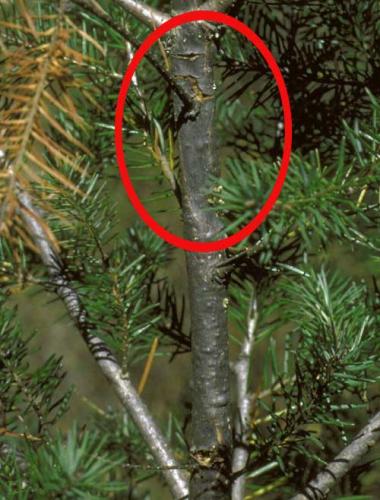Watch for cankers on leaders of Douglas fir this spring
Temperature fluctuations in January may cause tissue damage on Douglas fir leaders, increasing their susceptibility to fungal infections this spring.
This January 2013, Michigan has experienced unseasonable temperature extremes with many parts of the state recording 25 to 30 degrees Fahrenheit temperature swings in a 24-hour period. In past years, these extreme conditions have been associated with increased leader death in Douglas fir.

Canker on trunk of Douglas fir. Note the contrast
between the sunken brown lesion and the healthy bark.
Photo credit: USDA Forest Service Archive, USDA Forest Service, Bugwood.org
Contrary to popular belief, plant damage is not generally caused by an unusually cold winter. More often winter damage is associated with extreme temperature fluctuations. Under normal conditions, trees become dormant sometime in the fall. As trees become dormant, their cold hardiness increases due to several factors including the ability to supercool or resist freezing at temperatures below 32 F (0 C).
After trees gain the ability to supercool, they are capable of withstanding extreme cold temperatures until the resting or dormant period of the tree is completed sometime in mid- to late late winter. During extended periods of mild winter weather, trees can lose hardiness, again making them vulnerable to injury from rapid temperature drops. These swings can cause wounding on the bark on the leader, top whorls and sometimes even the trunk of the tree. These wounds allow fungi that are unable to invade healthy bark to gain entry into the tree and become established. Other points of entry can be through short, dead pruning stubs, poorly healed pruning cuts or other injuries that cause wounds to the tree.
Weak pathogens such as Valsa, Cytospora, Leucostuma and Dermea fungi are some of the species that are able to colonize the freeze-damaged tissue and form cankers, causing dead terminals to appear in late spring and throughout summer. Symptoms include dark, sunken cankers that expand along the twig, trunk, leader or limbs and sometime will produce large amounts of sap and small eruptions in the bark about the size of a pin-head.
Michigan State University Extension educators will discuss management and corrective pruning options in the next article, "Overcoming leader loss from cankers on Douglas fir."



 Print
Print Email
Email

